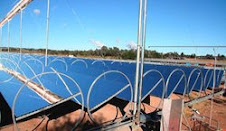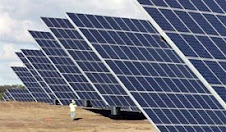African solar farms to solve energy crisis?
from Business Green Blog
It appears the UK government is not the only one busy commissioning reports on combating climate change, the German government has now got in on the act with two major new study's on the viability of a leftfield plan that could deliver clean energy to the whole of Europe within the next forty years.
The two reports from the German Aerospace Centre – Concentrating Solar Power for the Mediterranean and Trans-Mediterranean Interconnection for Concentrating Solar Power – investigate how vast new solar farms in the deserts of North Africa could potentially solve Europe's emerging energy crisis and help slash the continent's carbon emissions.
Satellite-based studies cited in the report show that deploying relatively simple concentrated solar power (CSP) systems over just 0.3 percent of the deserts in the Middle East and North Africa would provide enough power to meet current and future demands from the EU, the Middle East and North Africa.
The reports also argue that the technologies to achieve this are already well established and proven. CSP plants work by using mirrors to heat water, thus generating steam capable of powering turbines and generating electricity.
The report claims CSP is considerably more effective than photovoltaic solar panels, which tend to be at the mercy of the weather, and cannot store power effectively. In contrast CSP systems can store unused heat in tanks of molten salt, which can then be used to power the turbines at night. Equally, because the system is turbine based hybrid plants can be set up so that if there is a protracted period of overcast weather - in itself unlikely in North Africa - traditional fuels can be used to heat the water and drive the turbines.
Desalinated sea water can also be produced as a byproduct of the process, providing clean water for irrigation or air conditioning purposes.
The reports argue that with vast swathes of North African desert available for the same price as a London broom cupboard the strategy is economically viable. The technology is also expected to become cheaper as producers of the mirrors used in the CSP plants begin to exploit greater economies of scale and the report estimates that the cost of using CSP plants to produce power equivalent to that gained from one barrel of oil will ultimately fall to just $20 – much less than the current $60 a barrel you pay for oil.
So if a technology that is essentially some giant mirrors and water pipes can all but halt global warming in its tracks why are solar farms not springing up across the Sahara as we speak?
Well, there is one rather large problem. Europe's power grid is currently built on alternating current cables, which are unviable for transmitting electricity all the way from North Africa as too much would be lost on the way. As a result the plan will only work if Europe switches to a High Voltage Direct Current grid whereby only 3 percent of the power is lost per 1,000km. In theory, this means power could be transmitted all the way to the UK with just 10 percent lost along the way, but as you can imagine moving to a completely different power grid doesn’t come cheap.
The German reports estimate that establishing a suitable transmission grid capable of delivering 100GW of solar power would cost €400bn. However, spread up until 2050 this would equate to just €13bn a year and the report argues much of the amount required could be raised through commercial investment with government's being called upon to provide just €10bn.
A scientific body called the Trans-Mediterranean Renewable Energy Cooperation has also been formed to promote and further investigate the idea and confidence is mounting that while the whole scheme sounds a bit space age it is a technically, economically and environmentally viable replacement for fossil fuels or nuclear power.
Convincing governments and energy firms to plough money into the scheme may take some doing, but as the German government's reports show it is something they are already actively considering.
Best Green Stocks Investing Blog
Friday, July 13, 2007
Subscribe to:
Post Comments (Atom)
Yuya Joe Blog
Lake Ontario Waterkeeper
The Daily Beast -Politics Blog
21stArch.com - 21st Century Architecture
Original Joe College Blog
WikiLeaks Foreign Policy Analysis
AGreenRealtor.com Real Estate Blog - Ecology Energy Efficiency
Best Green Stocks Investing Blog
PV Intell Photovoltaic Solar Stocks Investing
SEARCH Leading Alternative Energy and Ethical Investing websites

Custom Search
Daily Kos
Rare Earth Stocks Research
Patrick MacManus's Blog Peace and Collaborative Development
BeesTreesFrogsElephants.com - Nature and Ecology Blog
Research Green Energy stocks, Clean Energy investing information
Find wind power investing info online, clean energy mutual funds, geothermal stocks, solar energy investments.

Green Energy Investing Network:
Green Stocks Investing Clean Power Blog
SolarIntell.com Renewable Power Investing Website
Wind Intell.com Wind Energy Stocks Company Links
Geothermal Power Investing Public Companies
PV Intell.com Leading Photovoltaic Solar Energy Stocks

Custom Search
Green Energy Investing Network:
Green Stocks Investing Clean Power Blog
SolarIntell.com Renewable Power Investing Website
Wind Intell.com Wind Energy Stocks Company Links
Geothermal Power Investing Public Companies
PV Intell.com Leading Photovoltaic Solar Energy Stocks







2 comments:
Thanks for this. A few points:
* The proposed HVDC Supergrid would not replace existing HVAC grids, it would complement them and reinforce them.
* There are several other good reasons for building this kind of Supergrid (see http://www.trec-uk.org.uk/elec_eng/grid.htm).
* The estimated cost of a 100 GW grid is EURO 45bn not EURO 400 bn.
Further information about concentrating solar power (CSP) and highly-efficient HVDC transmission may be found at:
http://www.trec-uk.org.uk/index.htm
and
http://www.trecers.net/index.html
and
http://www.trec.net.au/
Hi Gerry,
Thanks for the comments and the valuable URLs for Supergrid and concentrating solar power (CSP) and high-efficiency HVDC transmission.
Peace,
Yuya Joe College
Post a Comment